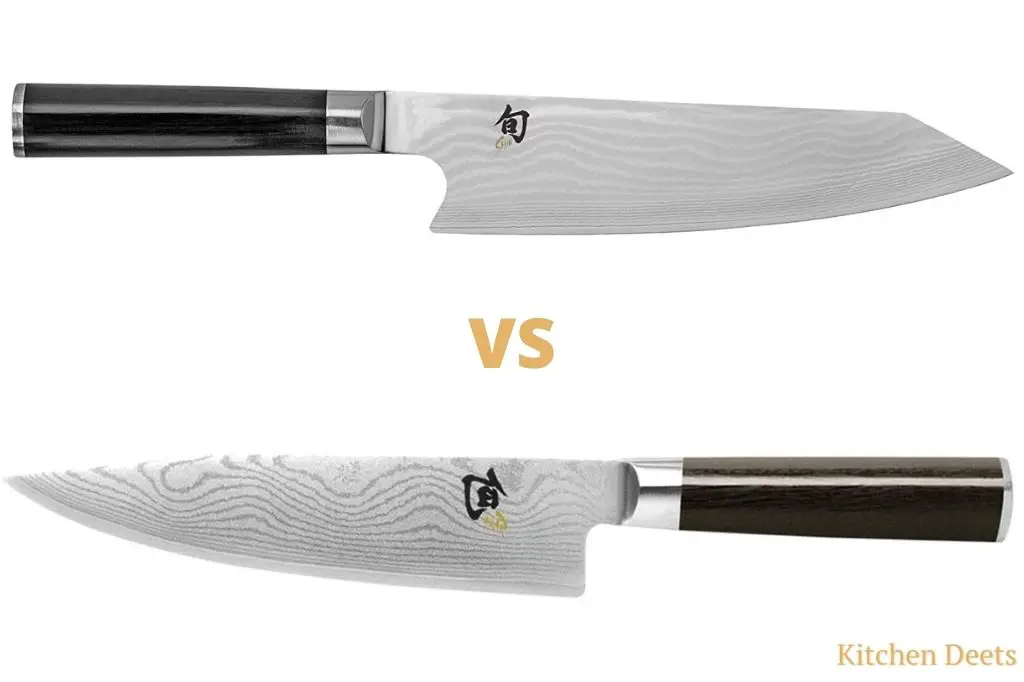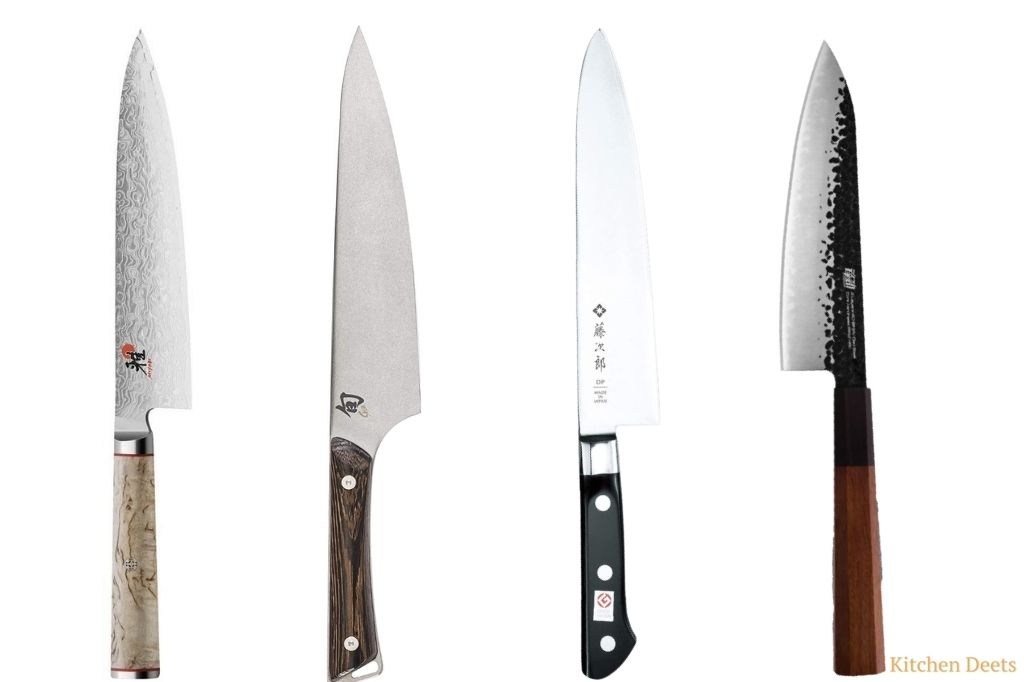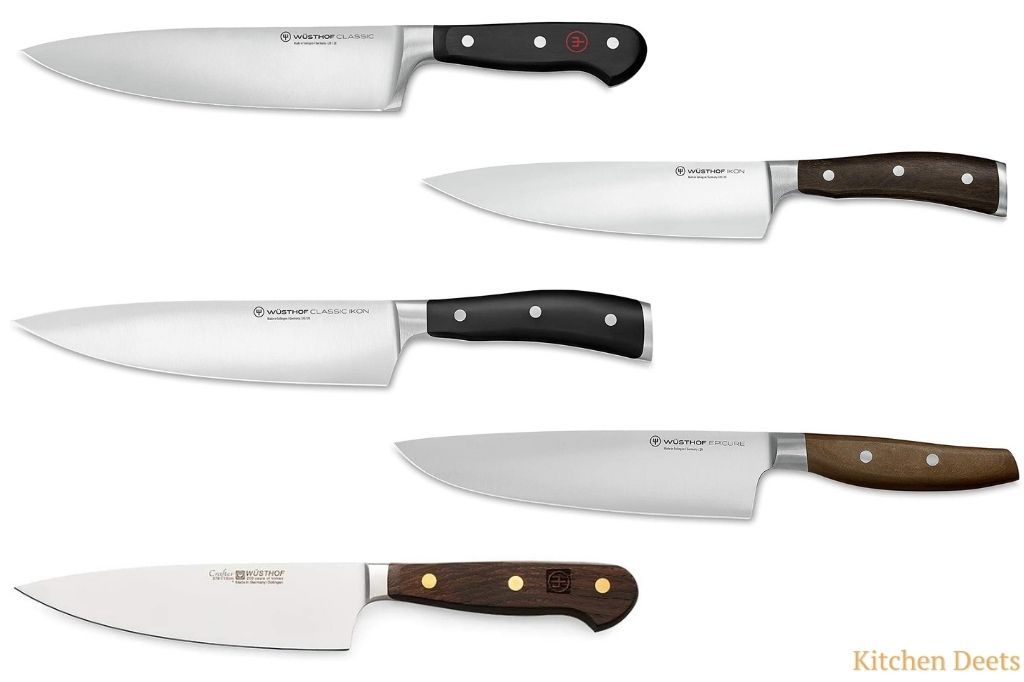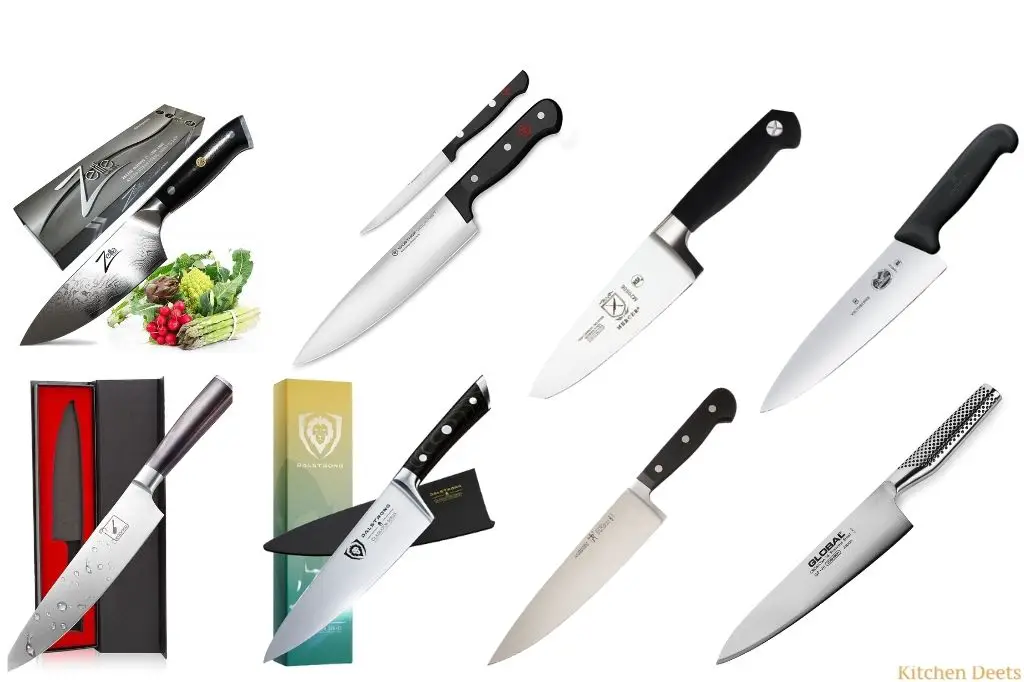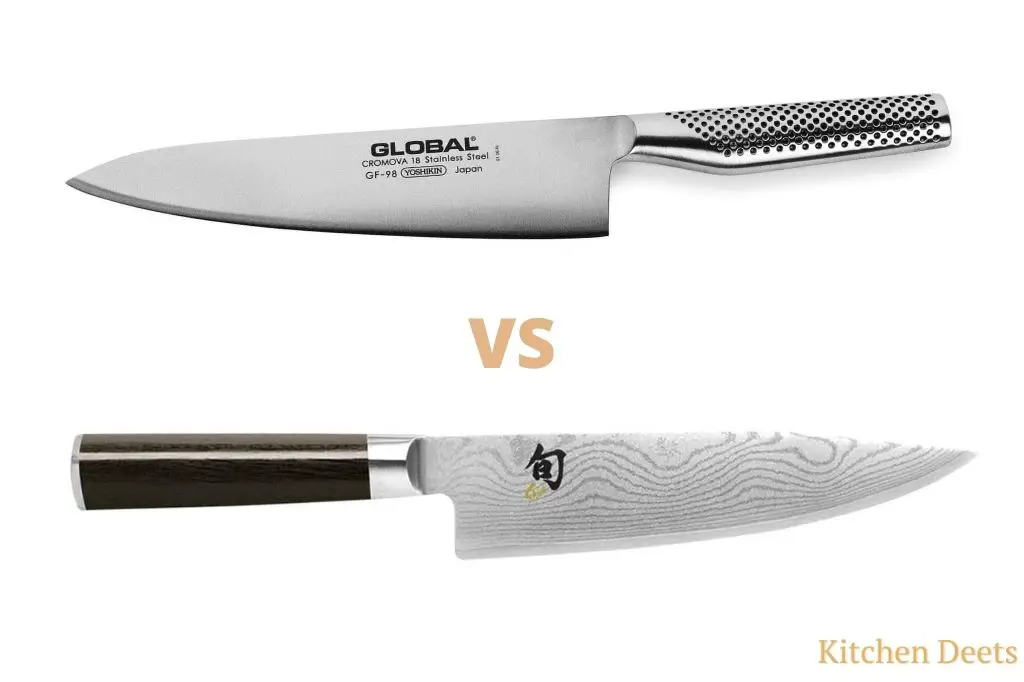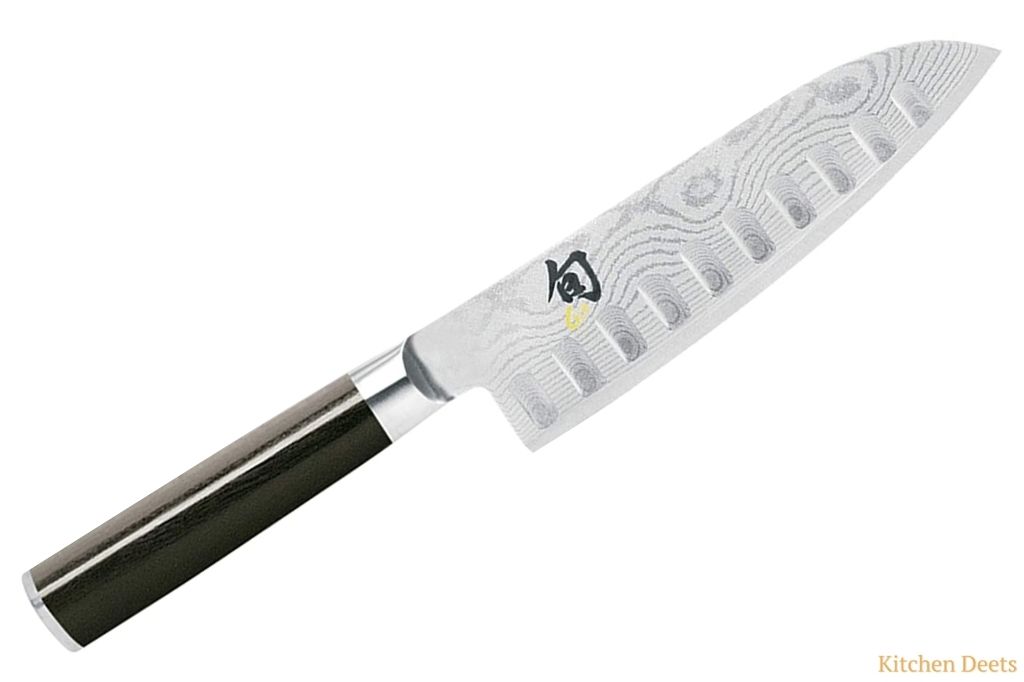The two most common knives used in the kitchen are Kiritsuke and chef knife. Both the knives have completely different usage as well as different designs, size, shape, quality, materials used in their making.
If you’re looking to buy your first Japanese knife, the choices can be overwhelming and confusing – especially if you don’t know how to differentiate between different knives. For those just getting started with cooking. Choosing between Kiritsuke and chef knife can be even more confusing. A Kiritsuke resembles a chef knife but has slightly less sharpness and curvature to do its job quickly and efficiently.
To help you decide which blade will best suit your needs, we’ve created this detailed comparison of Kiritsuke vs Chef knife to highlight each knife’s advantages and Limitations so that you can find the one that works best for you.
Use links below for easy navigation
Kiritsuke Knife, Advantages and Limitations:

Kiritsuke is a hybrid Japanese knife used for slicing fish. It’s different from chef knives, which are used for chopping, dicing, slicing and mincing vegetables, fish and meat. These knives are typically all-purpose blades with an angled tip to reduce sticking in slices of fish.
The blade of a Kiritsuke knife is longer and thinner than a chef’s knife and has a sharp tip for precision slicing. Its name literally means “slit open” in Japanese.
Kiritsuke’s thin blade is ideal for slicing fish like mackerel, tuna, salmon, and other seafood. Although it is typically used to slice the fish along the grain (across the diagonal), it can also be used to cut vegetables like cucumber or tomato with minimal effort. Additionally, Kiritsuke is perfect for filleting skinned fish like trout and red snapper.
These knives come in a variety of shapes and sizes to meet your cutting needs and can be either made out of carbon steel or stainless steel. A Japanese-made Kiritsuke knife will cost you about $100-$120 on average.
Check out our article on Santoku vs Chef Knife
Advantages:
Kiritsuke has a very sharp blade.
Unique shape.
Precise cuts.
Angled tip helps in cutting vegetables.
Perfect for filleting skinned fish.
Made from stainless steel.
You can create different types of cut by using this knife
Disadvantages:
Not very beginner-friendly.
Knife needs proper care.
Not the perfect knife to chop vegetables.
Single Beveled.
Handle also becomes slippery after few uses.
Chef Knife, Advantages and Limitations:

A chef’s knife is a knife used in food preparation for cutting large pieces of vegetables, joints of meat, and other foodstuffs. They generally have a blade of 12–20 cm (6–8 inches) and are easy to use.
Though there are many different types of chef knives, most fall into two categories: Western-style chef knives and Japanese-style chef knives (Gyutos). Both styles can be used to dice vegetables or meat, but Kiritsuke knives excel at slicing fish.
The chef knife is lighter than the kiritsuke and has a straight blade that is used in chopping and slicing vegetables and fruits. It also has serrated edges on the blade, which means it can cut through food with little resistance.
Check out our comprehensive review on Shun Knives
Advantages:
Versatile knives.
Top-level production.
Easy and comfortable grip.
Most knives come with a lifetime warranty.
Chef knives can cut vegetables, fish, even meat.
Ideal length.
Cuts food with little resistance.
Some chef knives feature beautiful Damascus patterns.
Double beveled.
Less Expensive than Kiritsuke.
Limitations:
Requires proper care.
May chip if used improperly.
Immediate hand wash after use.
Check out our article on Chef knife vs Carving knife
Chef knife vs Kiritsuke, Differences between Them:

Kiritsuke and chef knives are similar, but their main purpose differs. Kiritsukes are ideal for slicing fish while chef knives are best for chopping, dicing, slicing, and mincing vegetables, fish, and meat. Let’s take a look at them side by side to check out what’s so different about them.
Blade Length:
Kiritsuke knives are known for their thin blade, which allows them to perform delicate precision cuts. Chef knives are more used for cutting through bone and thick meats. Kiritsuke-style knives can range in length from 8 to 12 inches. Whereas, Chef Knives have a length of 8-10 inches.
Blade Curve:
Kiritsuke has a straighter blade with a dull edge, also known as Yanagi in Japanese. This makes it suitable for slicing fish. On the other hand, the curve on a chef knife blade is quite different than that of a kiritsuke.
A chef knife blade curves only at the tip, providing for very minimal rocking motion. The purpose of these curved blades is to allow more controlled cutting, particularly for fine dicing and chopping. This also makes it easier to apply pressure over a broad area of food during slicing, which is essential when cutting thick or hard vegetables like carrots or potatoes.
Weight:
Kiritsuke chef knives are significantly lighter than their chef knife counterparts. The lightweight of these knives can make them ideal for chefs with hand pain. Kiritsukes typically weigh between five to seven ounces. This is a stark contrast to traditional chef knives, which usually weigh between seven to nine ounces.
Single or Double Bevel:
Kiritsuke knives are mostly single bevels. On contrary to that, Chef Knives are double bevels.
Check out our article on Gyuto vs Santoku knives
Kiritsuke a hybrid knife:
A Kiritsuke is also referred to as Usuba or Gyuto, depending on its size and blade profile. A Kiritsuke differs from a chef knife in that it’s thinner, lighter and has a sharper edge. The Japanese consider a Kiritsuke to be one of their sharpest knives.
Prices:
Kiritsuke chef knives usually cost a little bit more than your typical 8-inch chef knife. The price can range from $100-$200 for a decent quality Kiritsuke knife. As for a good quality chef knife, you can get one for about $40-$70.
Check out our article on Nakiri vs Santoku Knife
What is a Kiritsuke knife used for?
A Kiritsuke is a Japanese-style knife that’s typically used for slicing food. It has a lighter blade than a chef or paring knife and can be used to slice through thicker pieces of meat and fish.
A Kiritsuke is also useful when cutting boneless meat like chicken breasts or tuna steaks because it allows you to cut more quickly through the meat when you’re making thin slices.
What is a Chef knife used for?
Chef knives are similar to Kiritsukes in that they have sharper blades than paring knives, but they’re not as light as Kiritsukes. These knives are great for chopping vegetables like onions or potatoes into smaller pieces.
They’re also good for cutting herbs into fine pieces so they’ll release their flavors when cooking.
Final Thoughts on Kiritsuke vs Chef Knife:
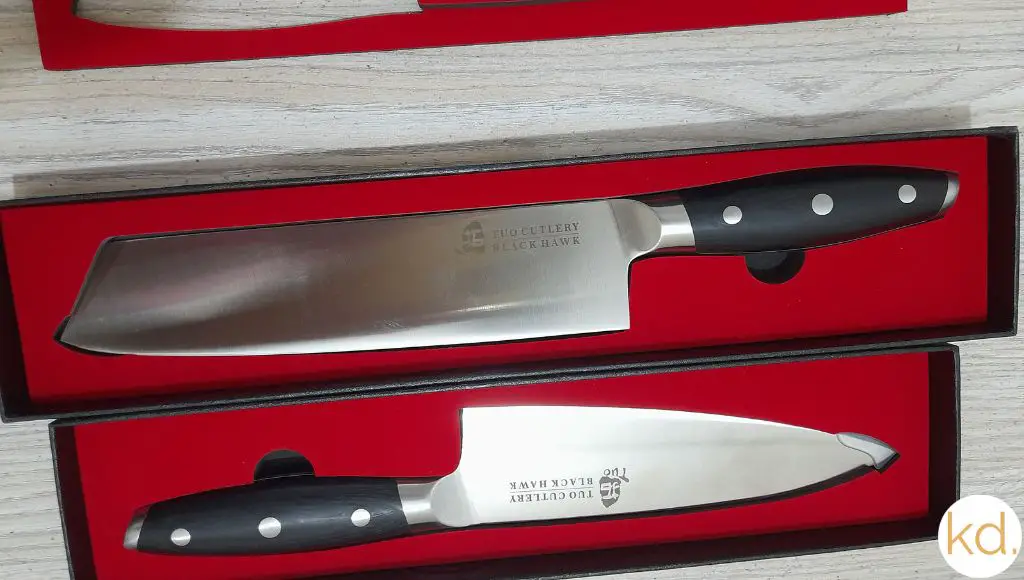
Kiritsuke and chef knives are Japanese-style blades, so they may look similar to a layperson’s eye. However, they do have subtle differences that determine which knife you should reach for in certain circumstances. Choosing one over another doesn’t have to be so black-and-white; consider what you plan on using it for.
If you want a knife just for gutting fish, a kiritsuke would be a great choice. However, if you’re looking for a more multi-purpose knife, a chef knife would do the trick.
We at kitchen deets hope this comparison helps you in making the smart decision.
